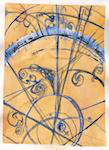Speaker
Description
The heavy-ion physics program at the LHC aims at characterizing the high energy density, high temperature, deconfined partonic state of matter called Quark-Gluon Plasma (QGP).
Azimuthal anisotropies of particles produced in heavy-ion collisions are used to study initial state geometry fluctuations and collective effects that arise from the long-range interactions with non-zero mean free path, between QGP constituents.
These anisotropies are used to quantify the shear and bulk viscosities, important properties used to characterize this high-density and hot medium.
Heavy quarks, being produced in the early stages of the collisions, loose energy while passing through the QGP, via radiation of gluons or scatterings with partons of the medium. The measurement of the azimuthal anisotropies of hadrons containing heavy quarks, at low transverse momentum, can give insights into their participation in the collective evolution of the system and their possible thermalization.
Recent measurements showed that, also, high-multiplicity proton-proton (pp) and proton-lead (p-Pb) collisions present similar behaviours to the azimuthal anisotropies observed in Pb-Pb collisions and usually associated to the hydrodynamical characteristics of the QGP. The understanding of these effects in high-multiplicity hadronic collisions is still debated.
A review of the most recent ALICE measurements about heavy-flavour azimuthal anisotropies ($v_{n}$ coefficients) will be presented. Focus will be given on the results obtained with Run2 data in Pb-Pb and p-Pb collisions at $\sqrt{s_{\rm{NN}}}=5.02~\rm{TeV}$.




